project background 3 - field work
Once the planning and paperwork are done, getting to Tibet, getting around, and getting things done make for some pretty interesting experiences.
page 1 - science page 2 - origin and organization page 3 - field work

Short of actually coming along with us, the best way to get an impression of what our work in Tibet is like is to leaf through our image galleries. To try to give you some feeling for what it takes to get things done, below we describe some of the preparations that are necesssary and some of experiences we've had.
Getting ready
In theory southeastern Tibet can be visited any time of year, but in practice there are only two good windows when rainfall is a little lower and it's not too cold. May and June are good for general field work at lower elevations, but passes may be closed. October and November are also good, although rivers may still be high following the rainy season, and in November it begins to get quite cold. We usually begin plannning for a field season five or six months before it's time to leave. This usually starts with informal talks to narrow science goals and figure out who can go, and when, and where. Once we have a plan, we contact our Chengdu colleagues, who take on the onerous task of arranging the fairly complex permissions required for collaborative work in China and Tibet. If all goes well, we usually have our papers and permissions shortly before we're scheduled to leave.
Getting there
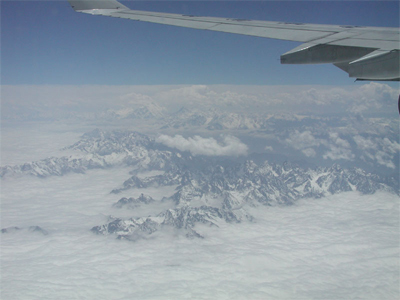
The southeastern edge of Tibet is rugged.
Travel to tibet starts with a long economy-class flight from the US to either Beijing or usually, Hong Kong (Chicago to Hong Kong can be over a 15 hour flight!). After a night's recovery in Hong Kong, we fly the three hours to Chengdu in Sichuan Province and spend a day or two consulting with our colleagues, taking care of finances, and finalizing equipment and plans. The flight to Lhasa takes about two hours and in clear weather is a spectacular traverse across the dissected eastern margin of the Tibetan Plateau; sometimes the flight passes right past Namche Barwa.
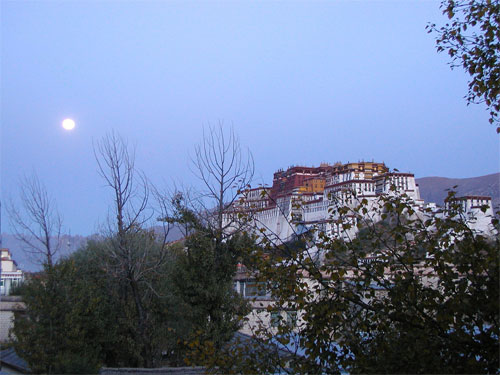
The Potala Palace in early-morning moonlight.
It's quite a jolt to the system to go from low-elevation Chengdu to Lhasa in just a few hours, as Lhasa is at an elevation of over 11,000 feet. Most people try to spend a day in town getting slighlty acclimatized. That first day, trudging up the steps with luggage makes you wonder how you're ever going to do any serious work.
Speaking of luggage, there's no way to travel lightly when heading off to do field work. Besides presentable travel clothes and incidentals for climates ranging from near-tropical to mountainous, we end up taking camping and trekking gear that has to include robust equipment for very wet weather and freezing temperatures. On top of that, we have various bits of field gear, cameras, hammers, sample bags, compasses, gps units, and a library of maps and reference material. Add to that any specialy gear like the stream-gauging instruments used by geomorphologists. And pity the poor seismologists, who have all sorts of specialized kit and computers to take along on top of the mountain for seismic gear that is shipped separately (this is a whole logistical story in itself).
Countryside, roads, people, weather

The main Lhasa-Chengdu road, under construction.
Although we try and do as much work by foot as possible (if nothing else than to stay fit), much of our work involves a great deal of driving. Although the roads in southeastern Tibet are rapidly being improved and paved, there are still many thousands of kilometers of rutted dirt roads that we need to traverse, and most of us have bounced along most of them, multiple times. The massive roadwork currently under way in Tibet is a mixed blessing, as it will improve people's lives materially, but with roads come changes in culture. For us, the impact has been massive delays, lots of rough travel, and frequent uncertainties about road closing. In general, dust and ruts are the biggest problem, but frequently enough the roads become seriously hair raising.
Our standard means of transport in Tibet is via Toyota Land Cruiser of widely varying vintages, each equipped with a good if idiosyncratic driver. It is entirely appropriate to say that when it comes to vehicles in Tibet, your mileage may vary. When it gets dark, and/or steep, there's a lot of silent back-seat driving and teeth gritting going on, because local drivers are sparing with their headlights, prefer not to downshift until below what feels like 100 rpms, and engage 4WD only as a last resort, when bogged, amidst the mud and rocks on a steep uphill, on an active landslide.

The horses arrive with the food and sweaters, at last.
Tibet is changing rapidly with increases in foreign and domestic tourism and improvements in transport and communications (cell phones are nearly ubituitous along the main road corridors--we use them too, to keep teams in touch with one another). Lots of even modest regional towns have ok hotels and good restaurants of the Sichuan style preferred by our mates from Chengdu. When we're working on roadside geology or in valleys where day trips are most efficient, we tend to drive a lot, eat too much, and live fairly comfortably. At other times, we need to access valleys in wich it takes a few days to walk in and out, and this means hiring a guide, porters and horses and working out plans for transport. It's proven fairly easy to work with porters, but the area does not have much experience with trekkers and climbers, so there are times when it is hard to find help, as people are busy getting on with their lives and our sudden arrival is a bit of a shock.
The hospitality of Tibetan people is tremendous. People are open and friendly, and particularly once you get away from the main road corridors, entering a remote village or shepherd's camp is quite an experience. In southeastern Tibet, several tribes that live near Namche Barwa have unique languages, so communication can be complicated, going from English to Chinese to Tibetan to Monba, and then back again. It's not always clear how well the orginal message survives this process!

A typical modest restaurant lunch.
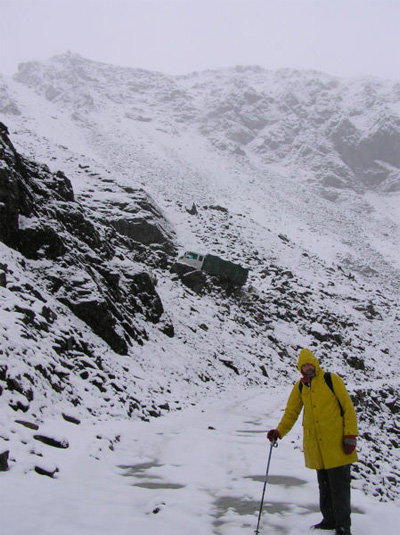
He's wet and he's cold, but Dave Craw is happy to be walking on this road.
Here's what a typical day is like. We're up around sunrise. After scrounging up breakfast either in a sleepy hotel restaurant or on the street (not a very exciting meal compared to dinner or lunch), if we're moving on to another town, everything has to get packed and loaded into the vehicle. We try to hit the road by about 8:30 or so (all of China follows Beijing time, so depending on the time of year, it takes a while to what used to doing things at odd times). Rain and showers are common in SE Tibet, and mountain weather is changeable, so you have to expect almost any sort of conditions at short notice. As a result people's day packs are usually crammed with rain gear and fleeces in addition to cameras, gps units, notebooks, map cases, hammers, sample bags, valuables, snacks, water, and food. Lunch will usually be some sort of improvised melange of local goodies and snack bars, unless we happen to be near a town, in which case a major 10-course Sichuan meal may ensue. We're usually back around dark, as it's not fun driving on the roads at night.
If we're arriving in a new town, we have to go through the ritual of finding a decent place if there is one, getting registered (which involves lots of passport-inspection), and schlepping all the gear to the rooms. After a shower or not, depending on the hotel, the electricity supply, and the local plumbing, we usually have quite a large and interesting meal, again usually of Sichuan style. After that people tend to retire for some reading, collating notes, organizing samples, and planning the next day's work. We usually don't plan rest days, because time in Tibet is valuable and if things can get done we do them, figuring that road blocks, schedule glitches, or really bad weather usually intervene to provide some time off. After an extended trek, we do usually take a day to clean clothes (and ourselves) and get some rest.
Deployment, care, and feeding of the seismic array
Most of the above routine also applies to the work done by our seismic team, led by PI Anne Meltzer. They do more driving, to be able to work with the some 80 seismometers that we have deployed over a broad region. What's really remarkable are the logistics involved in getting all the instruments to Tibet, installed, serviced, and ultimately retrieved and air-freighted back out. This can involve a sequence of jumbo jet, truck, jeep, horse, porter, and then the reverse, all for a huge pile of equipment.

Broadband seismometers, capable of recording signals across a wide range of frequencies.
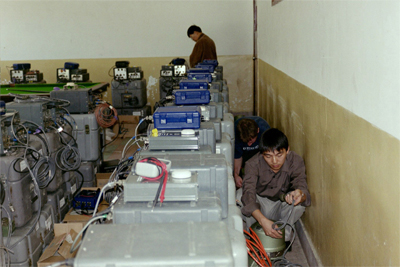
Huddle test for the main array, Lhasa.
Each full seismic station consists of an expensive, sensitive seismometer buried in a meter-deep pit for thermal insulation, control electronics and hard drives, a set of solar panels, and two car batteries. All of this has to be brought to the site, which we try to keep within jeep range if possible, but this isn't always the case. Before deployment, all the equipment needs to be tested in what's called a "huddle test" to make sure it survived the first phase of transport. Then the equipment needs to be dispersed to regional staging areas, and the sites, selected where possible on an earlier reconnaissance trip, need to be visited to arrange permission for the installation and payment for local people to keep an eye on the unit.
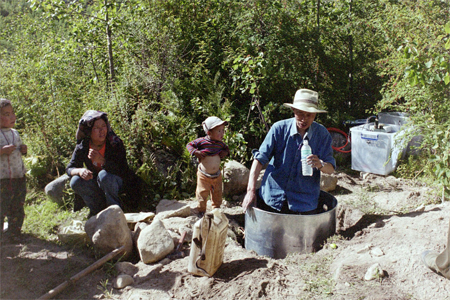
Lao Zhang emerges from a seismic vault.
Then the work of the installation begins, which can take anywhere from a few hours to two days. This involves digging the pit, pouring a concrete pad or installing some sort of rigid base, installing the unit and it's insulating foam housing and metal shell, setting up the rig for the solar panels, connecting everything, testing station health, setting up a housing or shelter for the electronics, and finally burying the station and any cables.
Once the station is installed, it is left to operate unattended for several months. We hope that there's enough good weather to keep the solar panels busy and the batteries charged, that no kids throw rocks at the station, or goats or cattle chew through cables, and that it keeps happily recording earthquakes until it's next visited. Even with modern large-capacity disk drives, it's necessary to swap new drives in every few months, and it pays to visit the station to check it's health and fix any problems. It takes two people to do this, plus some help with digging and lugging. During the initial deployment, two technical staff from the PASSCAL instrument center (the source of our instruments) joined our team to helped get things going and perform any troubleshooting and field repairs.
page 1 - science page 2 - origin and organization page 3 - field work
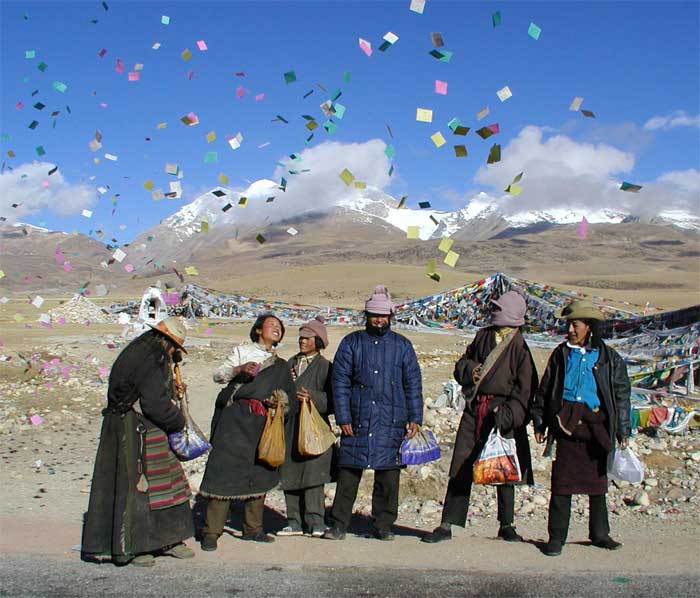
Prayers to the wind...